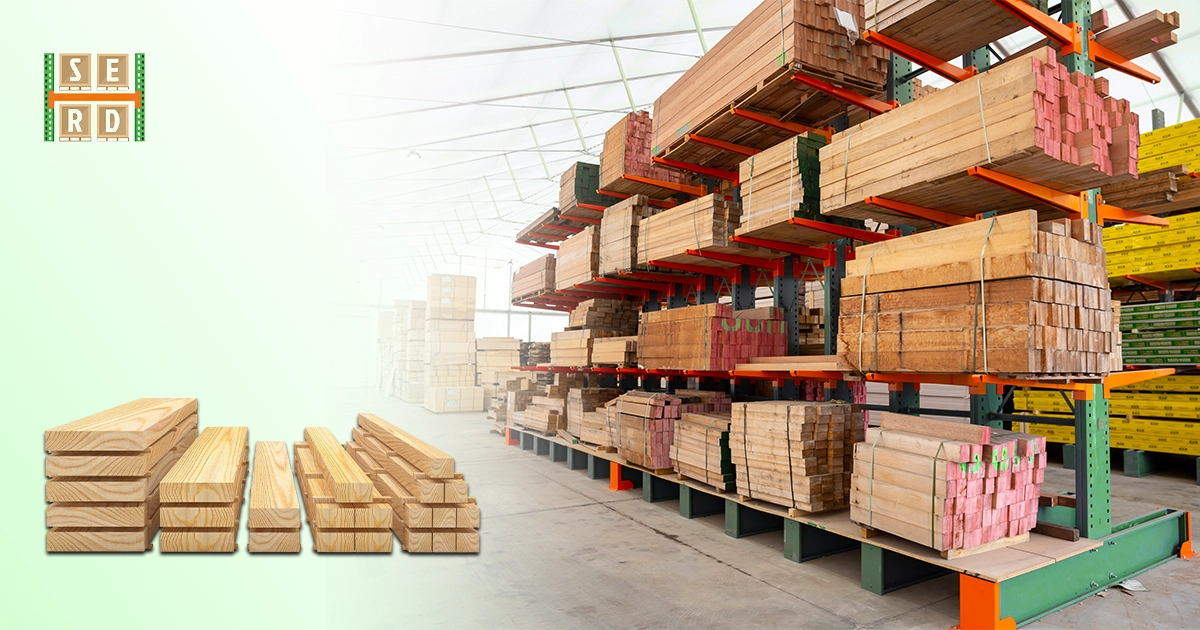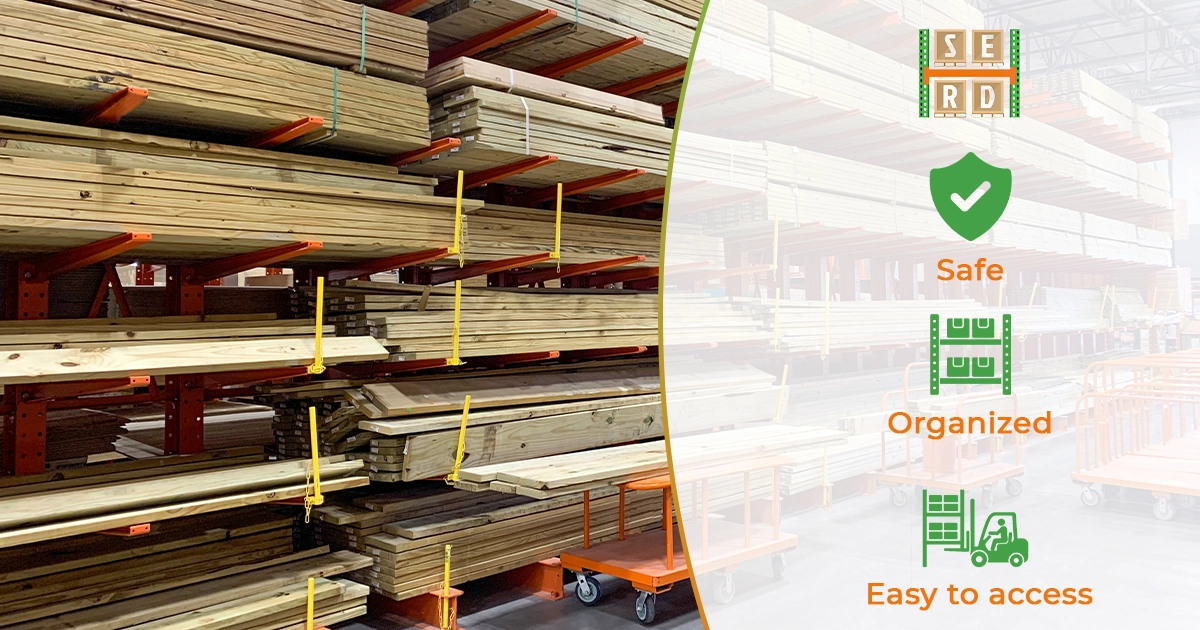


Timber Racking Systems for Safe Lumber Storage
Looking for a better way to store your timber? We design our Timber Racking Systems to handle heavy loads, ensuring your materials remain safe, organized, and easily accessible.
Built from strong steel and made for warehouses, workshops, and timber yards, these durable racking systems help you use space efficiently while reducing damage and clutter.
Keep reading to discover how the right timber racking system can transform your storage and make daily operations easier.
What Are Timber Racking Systems and Why Are They Essential for Timber Storage?
Timber racking systems are specialized storage structures engineered to hold long, heavy, or uneven pieces of wood such as planks, panels, and beams. They’re built to maximize vertical and horizontal space, preventing the need to stack timber directly on the ground, which often causes damage or warping.
By organizing materials on strong steel arms and beams, these systems create a safer, cleaner, and more efficient workspace. They also reduce manual handling and wasted space, allowing faster access, simpler inventory checks, and smoother operations in warehouses, timber yards, and production facilities.
How do timber racking systems keep your lumber safe and organized?
Timber racking systems protect timber by elevating stock off the ground and supporting it on engineered steel arms and beams that are securely anchored to the floor. Uprights and cross-bracing provide lateral stability, while adjustable arms and defined spacing let you store different lengths and bundle sizes without contact or overhang for those warehouse racks.
Design details such as inclined or anti-roll arms, head guards, and impact buffers prevent bundles from shifting or rolling during handling, and roller or cradle options ease loading and unloading. Together these features improve airflow around stored timber, reduce moisture-related damage, and make it simple to sort material by size, grade, or job cutting retrieval time and lowering handling losses.
What Makes Heavy-Duty Timber Racking Ideal for Industrial Use?
- Hot-rolled steel construction: Uses thick IPE or H-shaped beams for superior load-bearing capacity and long service life.
- High load ratings: Each arm or level can support hundreds of kilograms — ideal for industrial-scale timber bundles.
- Corrosion resistance: Powder-coated or galvanized finishes protect against rust and harsh weather.
- Outdoor-ready designs: Optional roofs, gutters, and back panels provide extra protection for exposed storage yards.
- Impact-resistant build: Designed to handle frequent forklift movement and heavy-duty use without bending or fatigue.
- Long-term durability: Engineered for years of continuous use in timber yards, sawmills, and manufacturing warehouses.
Which Type of Timber Racking System Best Fits Your Storage Needs?
Choosing the right timber racking system depends on the size, weight, and type of materials you handle, as well as how frequently you access them. Each system is designed to solve a specific storage challenge, whether that’s maximizing space, improving accessibility, or supporting heavy industrial loads. Below are the main racking options used in timber yards, warehouses, and manufacturing facilities, along with their key advantages.
Cantilever Racks
Cantilever racking is the most popular system for timber storage because of its open-front design, allowing forklifts or cranes to load and unload long materials easily.
- Ideal for long and bulky timber beams, boards, and panels.
- Free of front uprights, giving clear access to every level.
- Available in single-sided versions (for wall installation) or double-sided configurations (for central aisles).
- Can be fitted with adjustable arms to handle different timber lengths and weights.
- Excellent for outdoor timber yards and construction material depots.
Vertical Timber Racks
Vertical timber racks store materials upright, saving valuable floor space and allowing quick selection of individual items.
- Best for shorter timber profiles, panels, mouldings, or offcuts.
- Keeps boards organized and separated to avoid scratches and warping.
- Reduces clutter in workshops or production floors.
- Improves safety by preventing leaning stacks or piles of timber.
- Commonly used in joinery shops, carpentry workshops, and furniture manufacturing.
Horizontal or Roller Racks
Horizontal racking systems, often fitted with rollers, are designed to store timber bundles or panels flat and make loading more efficient.
- Timber rests securely on roller beds for easy movement and access.
- Suitable for sheet materials, plywood panels, and laminated boards.
- Minimizes handling strain and speeds up material retrieval.
- Provides stable storage for bulk timber stock or repetitive production runs.
- Works well in manufacturing and distribution environments where fast access is key.
Mobile or Adjustable Systems
Mobile or adjustable racking systems are built for facilities that need flexibility and high storage density.
- Racks move on rails or tracks, opening only one access aisle at a time to save space.
- Adjustable arms and beam levels accommodate changing timber sizes and bundle types.
- Increases usable floor area by up to 40% compared to fixed systems.
- Reduces travel time between aisles, improving workflow efficiency.
- Ideal for dynamic warehouses, custom fabrication shops, or areas with limited space.

How Can You Choose the Right Timber Racking System for Your Warehouse or Yard?
- Define load requirements: Identify weight, dimensions, and type of timber you’ll store.
- Measure space accurately: Plan for ceiling height, bay width, and forklift turning areas.
- Assess access methods: Ensure the design supports forklifts, cranes, or manual picking safely.
- Choose materials for the environment:
- Indoor: focus on space efficiency and workflow.
- Outdoor: use galvanized steel, drainage, and roof protection.
- Plan for flexibility: Opt for modular or adjustable racks to adapt as storage needs evolve.
- Check safety compliance: Ensure the system meets load-bearing, stability, and building code standards.
- Seek expert design input: Professional racking engineers can optimize layouts for maximum safety and capacity.
Choosing the right timber racking system is about more than just space; it’s about safety, efficiency, and future-proofing your storage operations. With the right system in place, your lumber stays organized, your team works faster and your warehouse becomes a strategic asset rather than a storage burden.
Ready to optimize your warehouse storage? Visit SouthEast Rack Depot today to get a quick quote on new or used timber racking systems, or speak with one of their warehouse consultants for tailored design and installation support.
Not Sure about what you need?
Contact a pro- Recent Posts
- Popular Posts
- Timber Racking Systems for Safe Lumber Storage
- Selective Pallet Rack for Efficient Warehouse Storage
- Drive-In Pallet Rack Systems for Georgia Warehouses
- Heavy Duty Racks: Durable, High-Capacity Industrial Storage
- Warehouse Racking Solutions in Atlanta, GA That Boost Efficiency and Maximize Space
- Drive-In Pallet Rack Systems for Georgia Warehouses
- Timber Racking Systems for Safe Lumber Storage
- Selective Pallet Rack for Efficient Warehouse Storage
- Warehouse Installation and Relocation: A Step-by-Step Guide for a Seamless Transition.
- The Impact of Smart Warehouse Design Consultation on Efficiency and Cost Savings.



